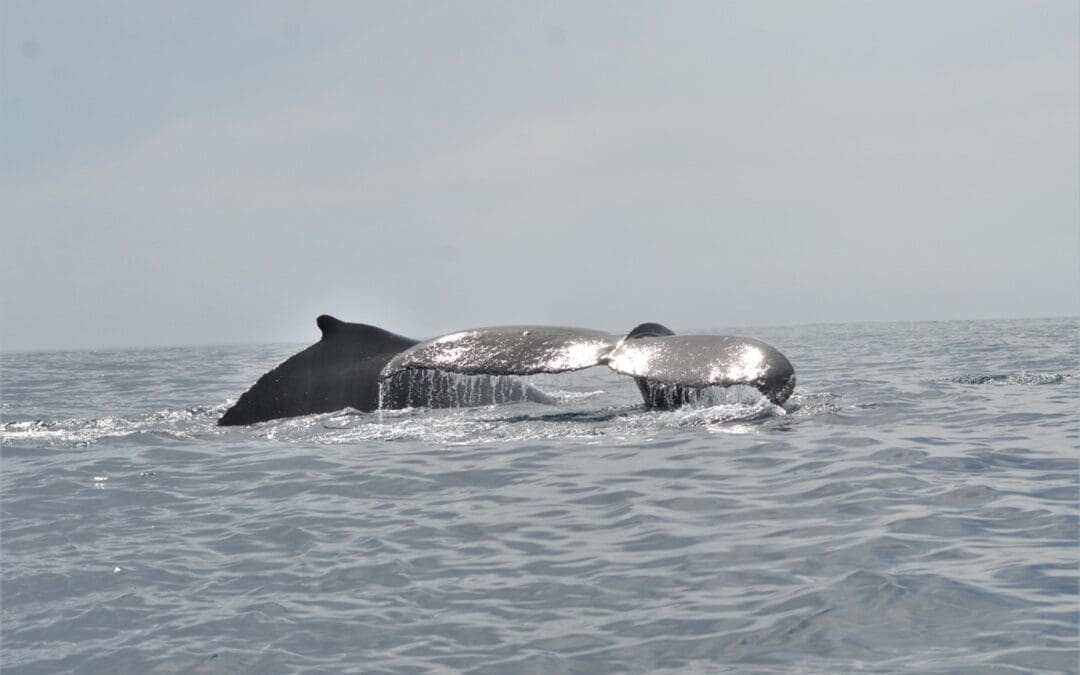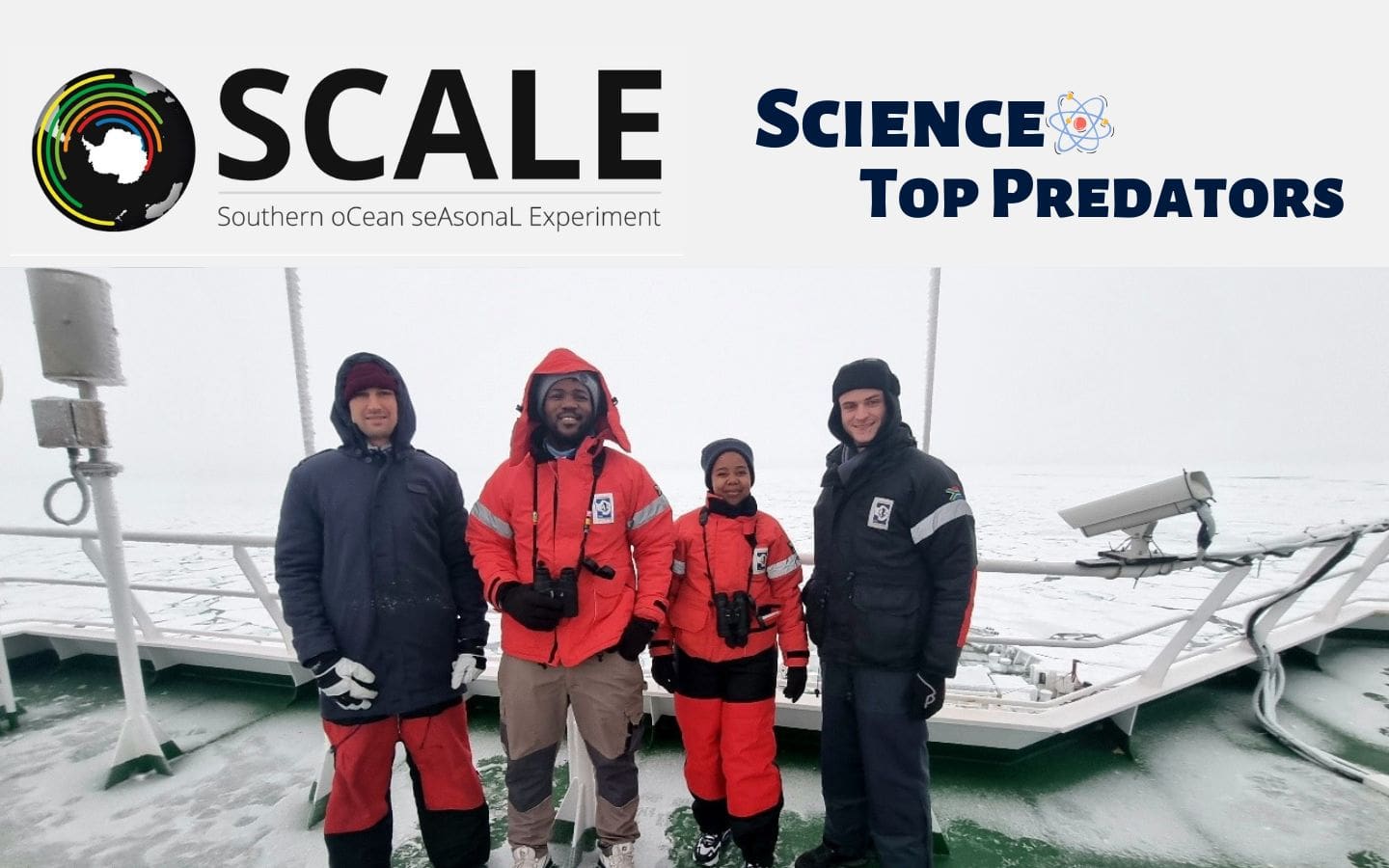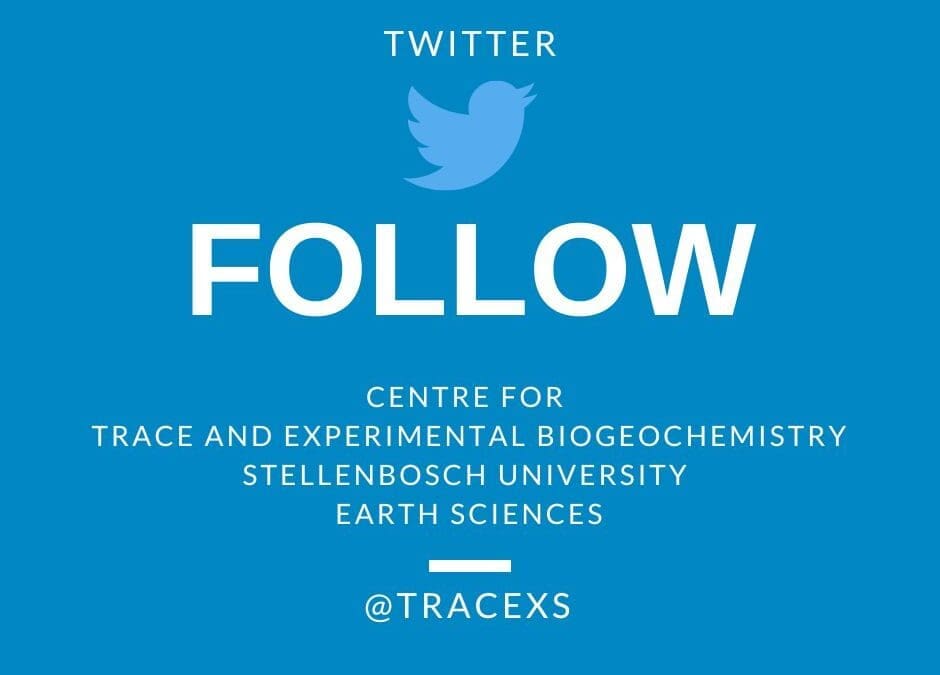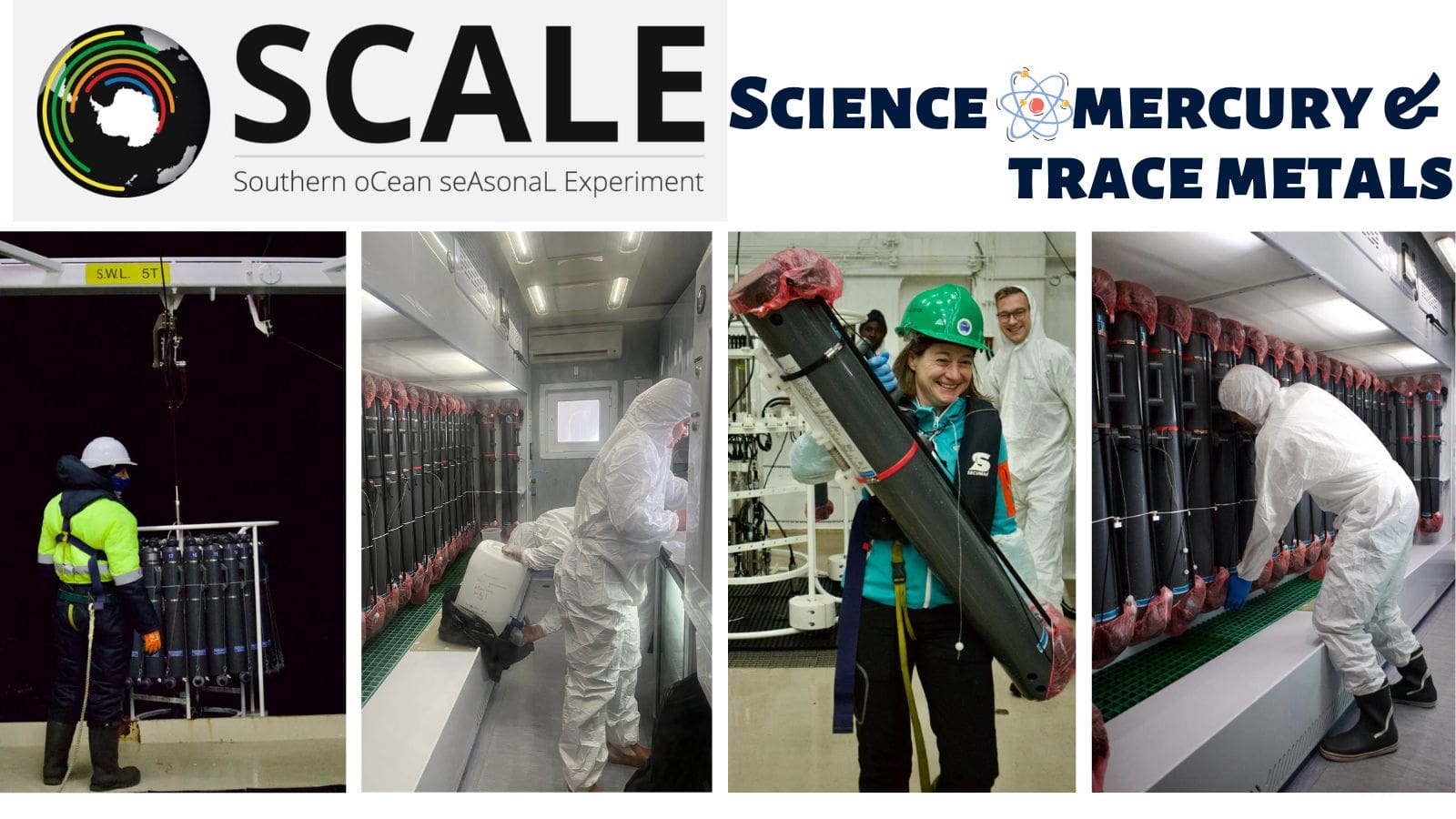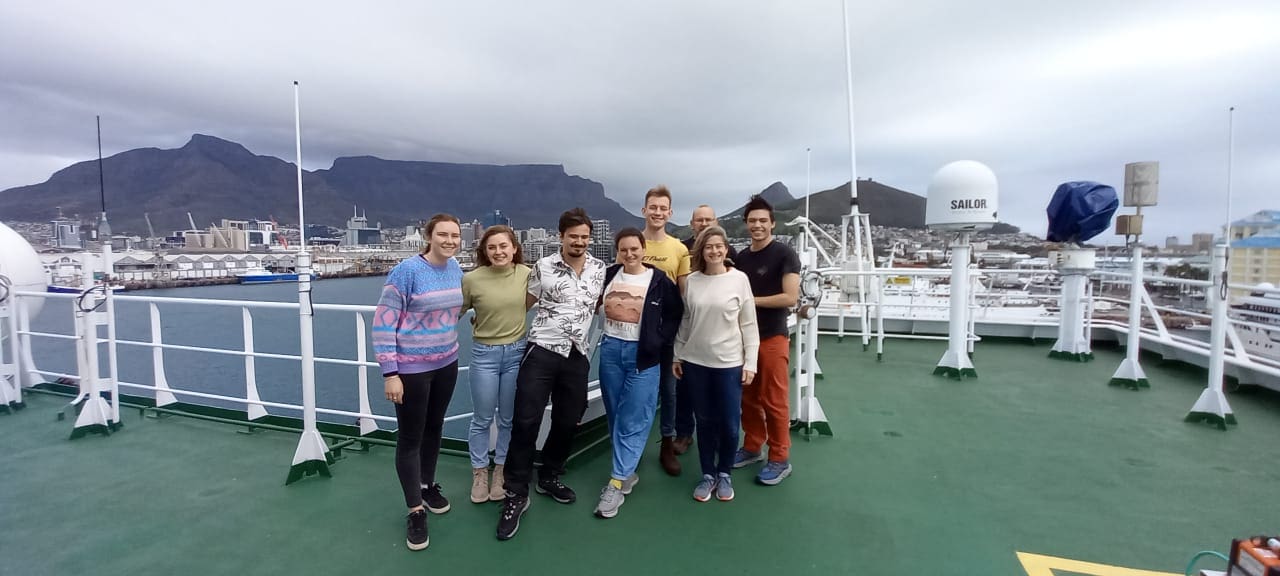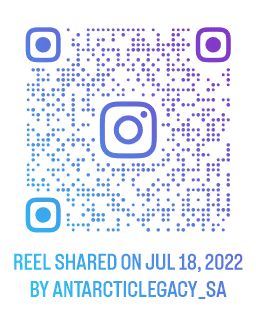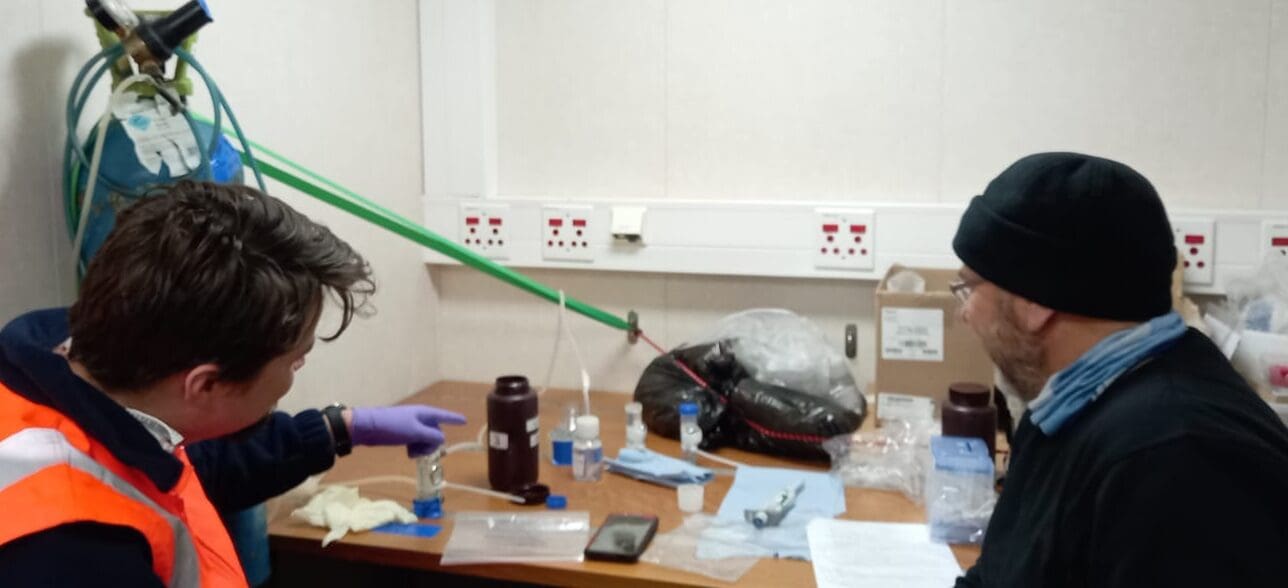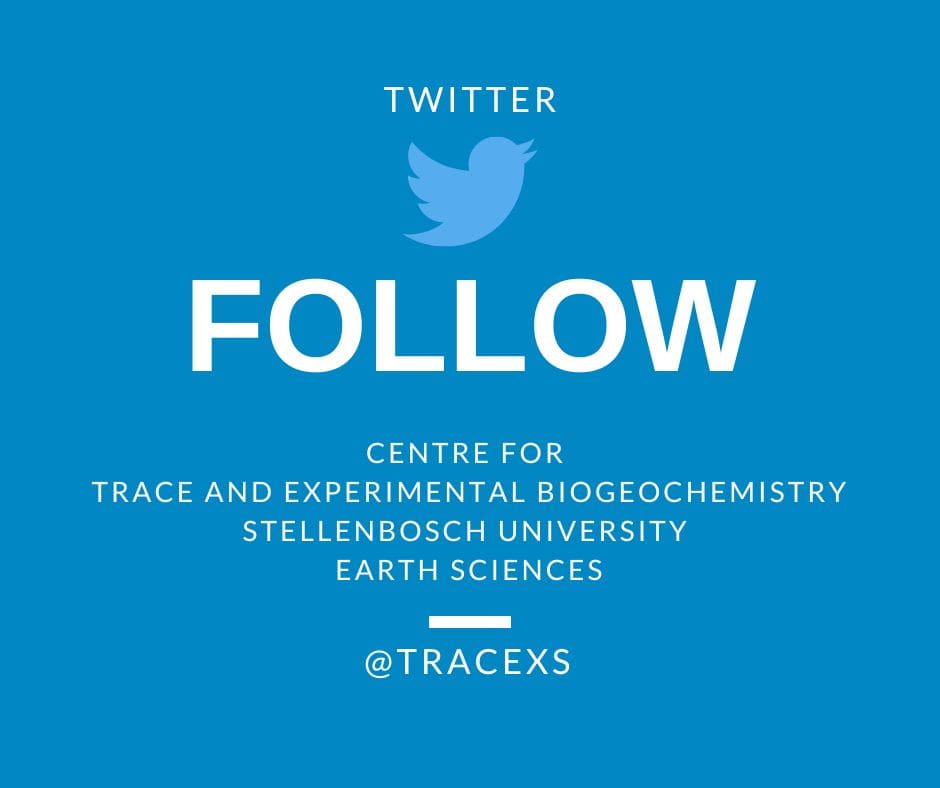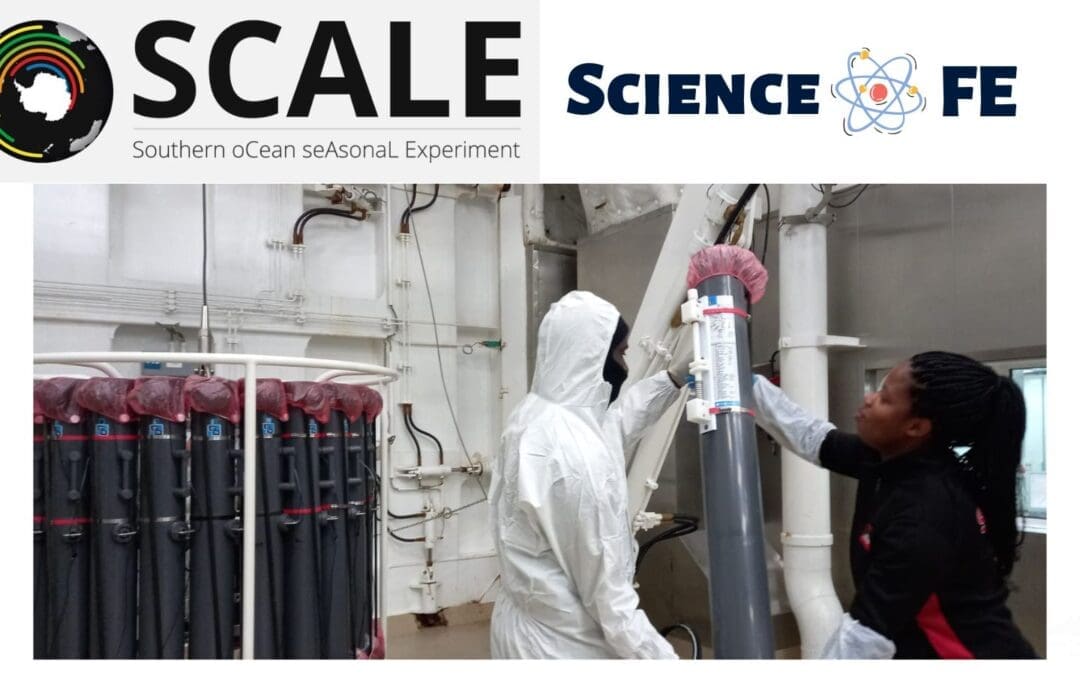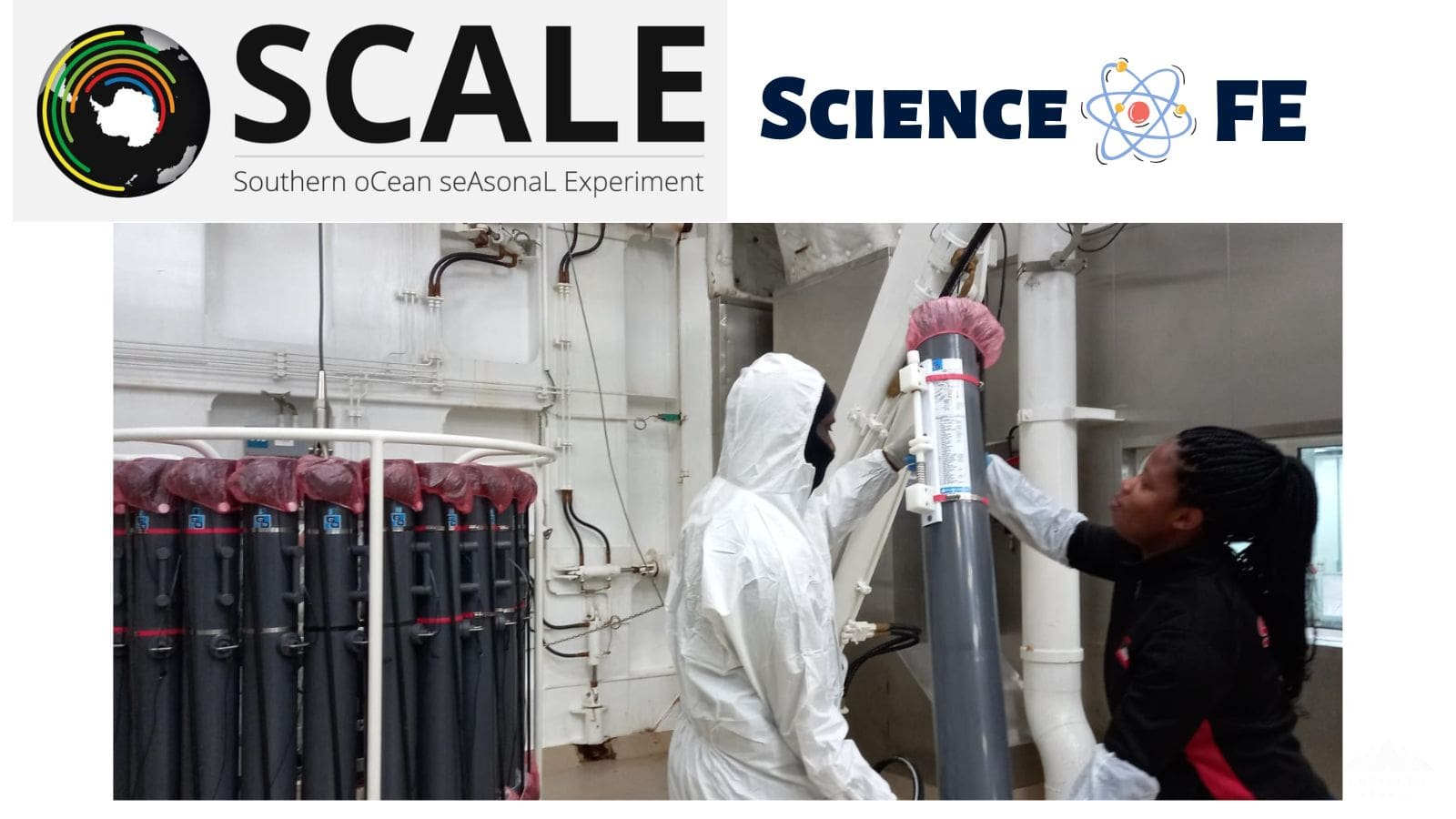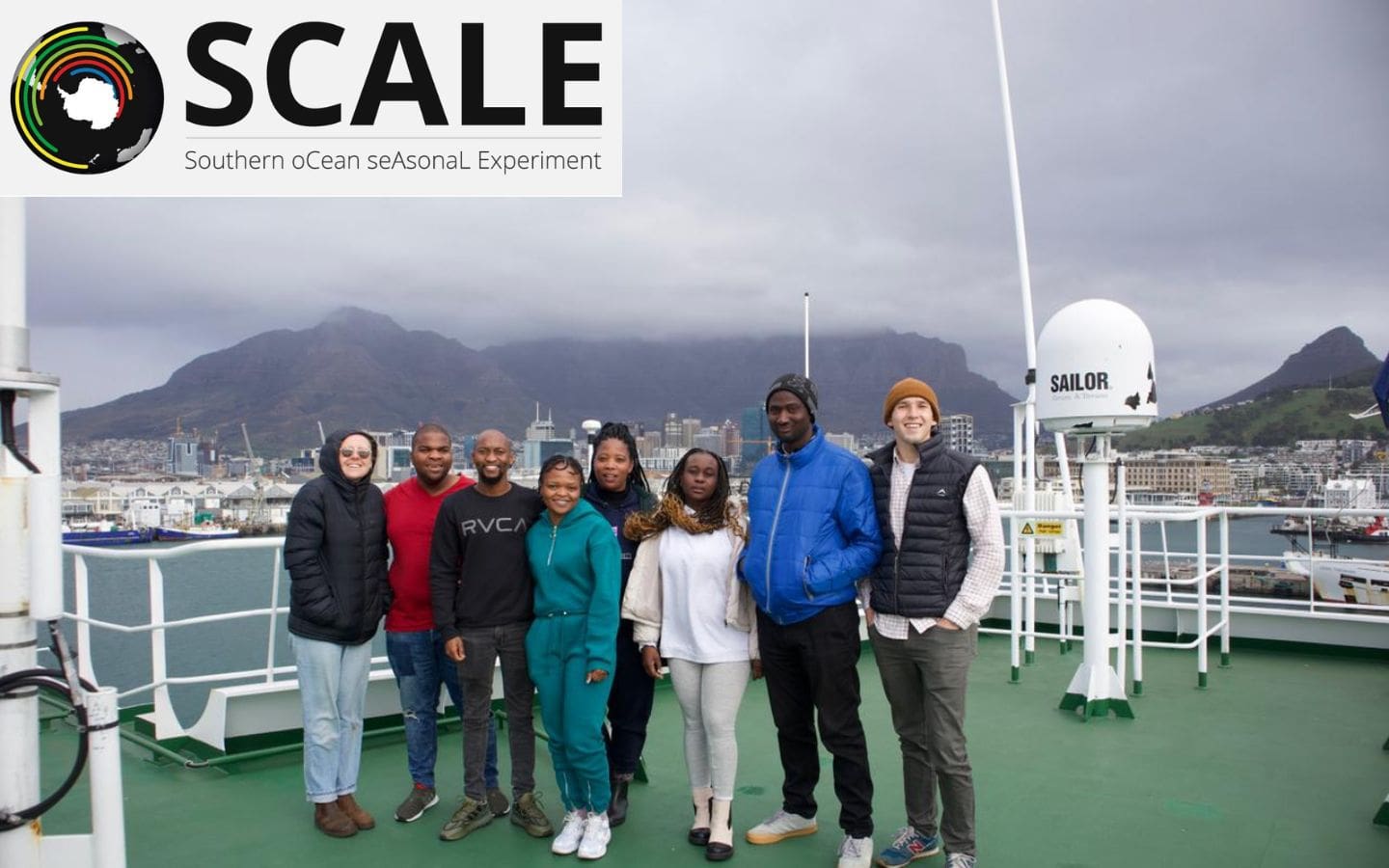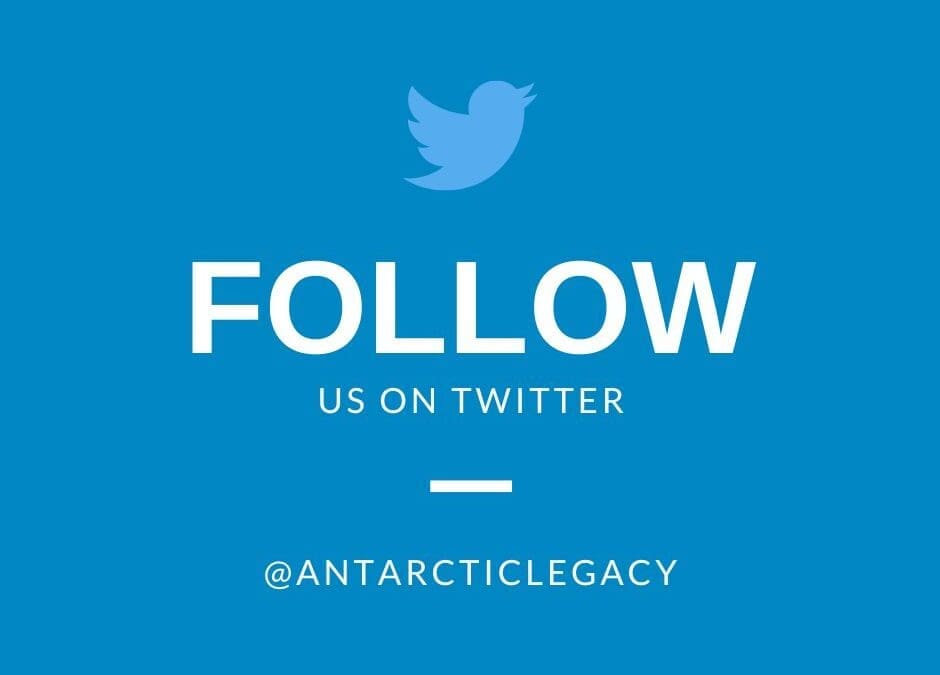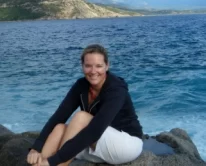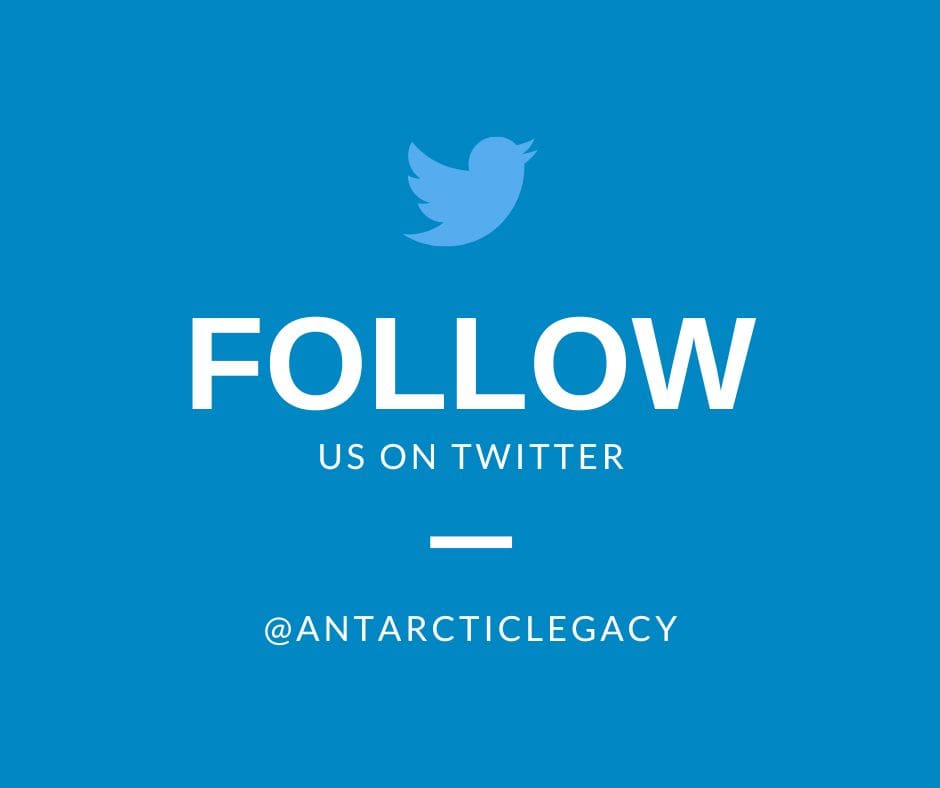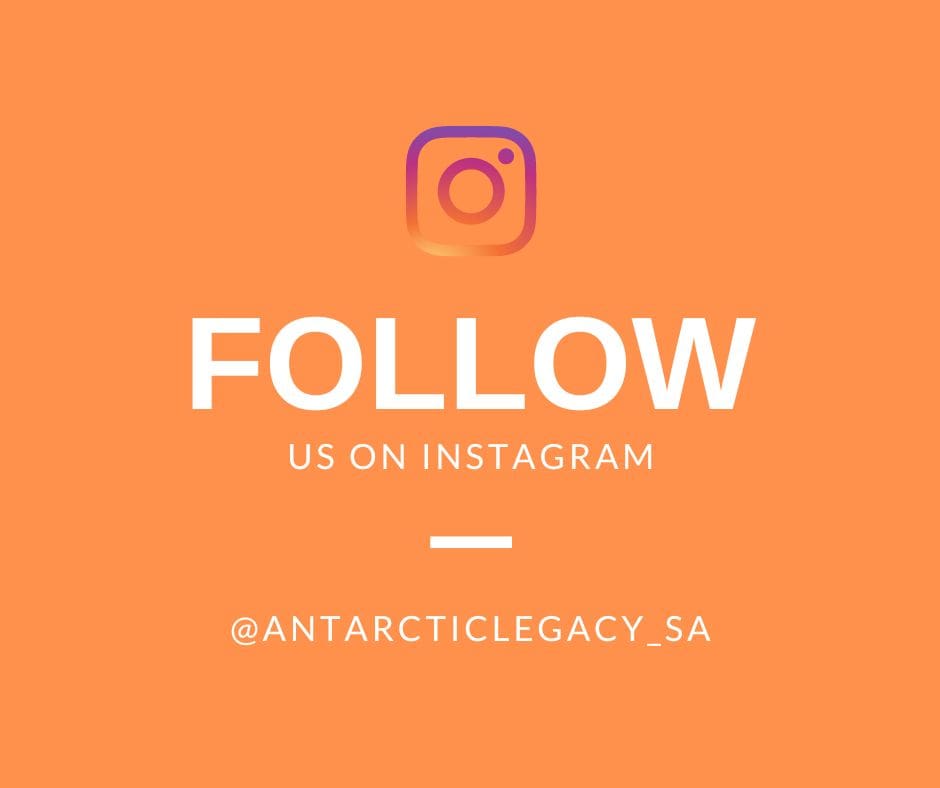
by Ria Olivier | Jul 29, 2022 | Antarctica, Current Event, Research, SA Agulhas II, SA Polar Research Infrastructure, SANAP, Science, Southern Ocean, STEM
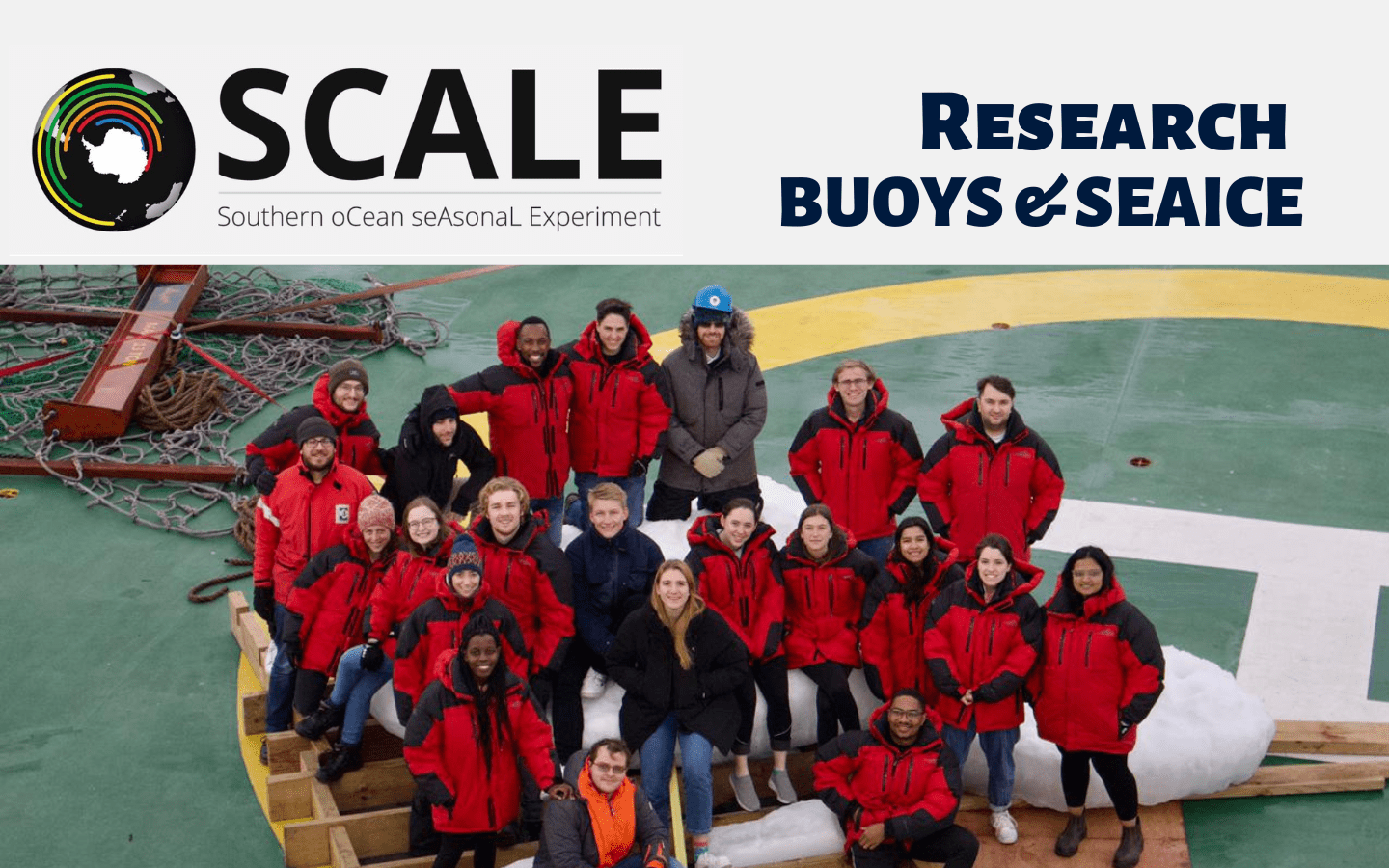
Team Buoys, team SEAICE and the logistics personnel involved in ocean operations.
| TEAM | BUOYS |
| Project name | A network of autonomous sea ice observation platforms in support of Southern Hemisphere climate predictions |
| Principal Investigator & Onboard Team Leader | Robyn Verrinder | University of Cape Town, Marine and Antarctic Research centre for Innovation and Sustainability (UCT-MARIS)
|
| Principal Investigator & ship based Chief Scientists of SCALE-WIN22 | Marcello Vichi | University of Cape Town, Marine and Antarctic Research centre for Innovation and Sustainability (UCT-MARIS)
|
| TEAM | SEAICE |
| Project name | Mechanical and biogeochemical properties of sea ice. |
| Principal Investigator | Tokoloho Rampai | University of Cape Town, Marine and Antarctic Research centre for Innovation and Sustainability (UCT-MARIS)
|
| Principal Investigator | Marcello Vichi | University of Cape Town, Marine and Antarctic Research centre for Innovation and Sustainability (UCT-MARIS)
|
Onboard BUOYS team members:
| Team Member | Role | Affiliation |
| Robyn Verrinder | Onboard Team Leader | University of Cape Town |
| Michael Noyce | MSc | University of Cape Town |
| Agoritsa Spirakis | MSc | University of Cape Town |
| Lawrence Stanton | MSc | University of Cape Town |
| Justin Pead | Senior Tech Officer | University of Cape Town |
| Ippolita Tersigni | PhD | University of Melbourne (Australia) |
| Giulio Passerotti | PhD | University of Melbourne (Australia) |
| Jacques Welgemoed | PhD | Nelson Mandela University |
| Francesca de Santi | Research fellow | University of Cape Town |
| Jan-Victor Björkqvist | Researcher | Finnish Meteorological Institute (Finland) |
| Alberto Alberello | Senior Research Associate | University of East Anglia (U.K) |
Onboard SEAICE team members:
| Team Member | Role | Affiliation |
| Siobhan Johnson | Onboard Team Leader | University of Cape Town |
| Felix Paul | Technician/PhD | University of Cape Town
University of Duisburg-Essen (Germany) |
| Safiyyah Moos | PhD | University of Cape Town |
Tamuka Keche
| MSc | University of Cape Town |
Hayley Swait
| MSc | University of Cape Town |
Magata Mangatane
| PhD | University of Cape Town |
Lisa Kumadiro
| MSc | University of Cape Town |
Dayna Collins
| Honours | University of Cape Town |
Onboard ocean operations logistics team:
| Team Member | Role | Affiliation
|
| Riesna R. Audh | Ice operations | University of Cape Town |
| Jonathan Rogerson | Ocean operations | University of Cape Town |
| Ashleigh Womack | Sea ice operations | University of Cape Town |
BUOYS: More about the project and the team:
A variety of synoptic, seasonal and interannual drivers influence the forms, types and concentration of sea ice in the Marginal Ice Zone (MIZ) in the Southern Ocean. The temporal and spatial distribution of the ice and its physical, mechanical and biological properties are directly related to the natural variability of the oceans and atmosphere, but also anthropogenic climate change. Climate and Earth System Models have limited sea ice variable parameterisations due to the scarcity of spatially distributed high resolution measurements from the region, specifically during winter/spring. To better understand atmosphere-ice-ocean MIZ processes and to improve future prediction of seasonal sea ice coverage and extent, three main approaches are available: (1) in situ measurements, (2) area-wide satellite data, and (3) numerical and experimental modelling. The meaningful connection of these is essential for enhancing understanding of this region.
Improved use of technology and autonomous devices, capable of persistent in situ sampling at finer spatial resolutions over the winter/spring seasons in the Antarctic MIZ, are key to obtaining the datasets needed to improve Earth System Models and to validate remote-sensing products. This requires a multidisciplinary approach including engineering, oceanography and climate science. The #SCALEwin22 expedition BUOY team comprises researchers and students from several institutes including the University of Cape Town (Robyn, Michael, Justin, Lawrence, Agoritsa and Francesca), Nelson Mandela University (Jacques), University of Melbourne (Guilio and Ippolita), University of East Anglia (Alberto) and the Finnish Meteorological Institute – FMI (Jan-Victor). During the expedition we aim to collect high-frequency wave and ice drift data using ice-tethered buoys (see images below) designed and built by the UCT team as well as open water buoys developed by Tallinn University of Technology and WiseParker OÜ. These measurements will be complimented by advanced ship-based imaging of ice floes and waves using LiDAR, stereo and thermal cameras. These unique high resolution data sets will be used to better characterise wave drivers of sea ice formation during winter and to inform Southern Hemisphere climate predictability.
SEAICE: More about the project
Analysis of structural, textural, and mechanical properties of sea ice in the Antarctic marginal zone.

Read more about the SEAICE team’s research here: UCT-MARiS
Check them out on Social Media:
Fearued Image: (Back) L-R: Jan-Victor Björkqvist (BUOYS), Giulio Passerotti (BUOYS), Alberto Alberello (BUOYS), Magata Mangatane (SEAICE), Robyn Verrinder (BUOYS), Justin Pead (BUOYS), Lawrence Stanton (BUOYS), Jacques Welgemoed (BUOYS); (middle) Francesca de Santi (BUOYS), Agoritsa Spirakis (BUOYS), Ippolita Tersigni (BUOYS), Michael Noyce (BUOYS), Felix Paul (SEAICE), Siobhan Johnson (SEAICE), Hayley Swait (SEAICE), Ashleigh Womack (Sea ice operations – logistics), Safiyyah Moos (SEAICE), Dayna Collins (SEAICE), Riesna Audh (ice operations – logistics); (front) Lisa Kumadiro (SEAICE), Jonathan Rogerson (ocean operations – logistics) and Tamuka Keche (SEAICE). Image Credit: Kurt Martin.
Images by Robyn Verrinder, Agoritsa Spirakis, Alberto Alberello and Kurt Martin (SAPRI trainee).
Buoys team text by Robyn Verrinder, Principal Investigator and onboard team leader.
Anche Louw, Antarctic Legacy of South Africa, 29 July 2022.

by Ria Olivier | Jul 26, 2022 | Antarctica, Current Event, Research, SA Agulhas II, SA Polar Research Infrastructure, SAPolarRI, Science, Southern Ocean, STEM

Top Predator team for seabirds and marine mammal observations during SCALE cruise 2022: (left to right) Matthew Germishuizen, Makhudu Masotla, Mpumalanga Mnyekemfu, and Estefan Pieterse.
| TEAM | TOP Predators |
| Project name | Top predator assemblages, distribution and abundance in the Southern Ocean |
| Principal Investigator | Azwianewi Makhado | Department of Forestry, Fisheries and the Environment (DFFE), Branch: Oceans and Coasts |
Onboard Top Predators team members:
| Team Member | Role | Affiliation |
| Makhudu Masotla | Team Leader
Research fellow
eDNA, Plastic pollution, At sea observer
| Department of Forestry, Fisheries and the Environment |
| Mpumalanga Mnyekemfu | Seabirds At sea Observer | Department of Forestry, Fisheries and the Environment |
| Matthew Germishuizen | Mammals At sea observer | Mammal Research Institute, University of Pretoria |
| Estefan Pieterse | Mammals At sea observer | Mammal Research Institute, University of Pretoria |
More about the project:
Seabirds and marine mammals are often the early indicators of changes in an ecosystem and display the effects of climate change vividly. Their distribution can be grouped into assemblages; which are species occurring in space and time. Ocean currents, physical and chemical forces generate nutrients necessary for primary productivity that accumulates biomass. These create hot spots of ecologically important zones for seabirds, marine mammals and several other marine taxa. There is a direct linkage of these structures to seabed topography, physical water properties and some oceanographic processes, such as fronts, eddies and local upwellings. Prey availability is mostly influenced by these features, therefore it is expected for top predators, such as seabirds to be found in these areas.
The overarching purpose of this expedition was to collect distribution and abundance data on seabirds, and marine mammals. We envisage several conservation applications using data that this project should generate, such as to define ‘ocean hotspots’, where visible marine life (such as seabirds or cetaceans) congregate in relative abundance and with some degree of consistency. Further objectives are to identify important areas for highly threatened species such as albatross and petrels. These areas might become marine Important Bird Areas or contribute to the designation of Marine Protected Areas, special nature reserves on the high seas, and no-take zones to protect sensitive species from commercial fishing. The additional aim is to determine the distribution and abundance of seabirds and marine mammals in the southern ocean in relation to a number of different environmental variables (e.g. surface temperature, chlorophyll, fronts, etc.) in order to address the knowledge gap around their at-sea movements in our study area.
Acoustic data
Antarctic krill Euphausia superba is a keystone species in the Antarctic ecosystem as it is prey to various top predators i.e. seabirds, whales, seals, and fish. To establish predator-prey relationships between marine mammals/seabirds and krill, acoustic data will be collected from three transducers (i.e. 38, 120 and 200 kHz) mounted on the drop keel of the SA Agulhas II. The data collection will not interfere with any other scientific operations and will be autonomously logged. Information produced by this study will give relative abundance and distribution of krill relative to the visually observed seabirds and marine mammals. This information will also be crucial for the management and conservation of different endangered marine animals.
Environmental DNA (eDNA) detection represents a powerful tool for assessing aquatic biodiversity and for the efficient detection of “hard-to-find species,” including top predators. Detection of a species-specific eDNA sequence implies the presence of this species in a certain area. Knowledge of prey items established using metabarcoding within the scats, guano, pellets, stomachs and regurgitates of mid-level and high-level components of the food web may highlight spatial differences in diet, behavior, or environmental pressure. Metabarcoding has the potential to assess the presence of hundreds of species in both the environment and the diet of predators. The top predators team will therefore be collecting eDNA samples towards the fulfillment of the metabarcoding objective.
Text and images: AB Makhado, M Seakamela, M Germishuizen, M Mnyekemfu, E Pieterse and MM Masotla.
Anche Louw, Antarctic Legacy of South Africa, 26 July 2022.

by Ria Olivier | Jul 20, 2022 | Antarctica, Current Event, Environment, Research, SA Agulhas II, SA Polar Research Infrastructure, SANAP, SAPolarRI, Science, Southern Ocean, STEM

| TEAM | MERCURY & TRACE METALS |
| Project name | Knowledge and technology transfer to investigate marine mercury contamination |
| Principal Investigator 1 | Susanne Fietz | Stellenbosch University (SU) |
| Principal Investigator 2 | Lynwill Martin | South African Weather Service (SAWS) |
| Principal Investigator 3 | Lars-Eric Heimbuerger | CNRS-MIO |
Onboard MERCURY & TRACE METALS team members:

Front (L-R): Kayla, Lide, David, Sonja, Susanne; (back) Liam, Casper, and Jared.
| Team Member | Role | Affiliation |
| Susanne Fietz | PI and Onboard Team Leader | SU |
| Liam Quinlan | MSc | SU |
| Jared Walsh | MSc | SU |
| David Amptmeijer | PhD | GMOS, Europe |
| Sonja Gindorf | PhD | GMOS, Europe |
| Casper Labuschagne | MSc | SAWS |
| Kayla Buchanan | Honours | SU |
| Lide Janse van Vuuren | MSc | SU |
More about their research:
Mercury is a natural element and its biogeochemical cycle is heavily altered by anthropogenic activities. Over the past two decades, it became clear that processes in seawater are largely responsible for the conversion from inorganic mercury to the bioaccumulative neurotoxin methylmercury, which accumulates up marine food chains. This is of special concern as globally the main pathway of human exposure to methylmercury is via the consumption of seafood.
The #SCALEwin22 expedition is extremely valuable to better understand mercury dynamics in the Southern Ocean. Observations from this region are rare, especially observations during winter. Sonja and David are both doctoral students within the “Global Mercury Observation and Training Network in Support of the Minamata Convention”, a Marie-Curie training network involving several institutions all over Europe. Together with the TraceEx team from Stellenbosch University: Susanne (Senior Lecturer at the Department of Earth Sciences), Lide, Kayla, Caspar, Liam, and Jared, water and ice core samples will be taken, for mercury speciation and dissolved trace metals.
In the water and ice, we are sampling for oxygen and deuterium isotopes, different dissolved organic matter parameters, and persistent organic pollutants to relate mercury biogeochemistry to different anthropogenic and environmental factors. Moreover, we sample for genes that are relevant in mercury (de-)methylation (see purging process below).
All our samples and work onboard are following trace metal clean protocols. Trace metal sampling in itself is tricky! We take a wide range of measures to keep our samples uncontaminated: we wear protective gloves, sleeves, and coveralls, and all our work happens in a metal-clean container.
During this voyage, the project also aims to transfer important skills to improve our understanding of the mercury cycle to South Africa. This project thus trains young researchers, transfers analytical skills, and provides data for an improved understanding of mercury cycling.
More about the sampling:
Gaseous mercury will be measured in the atmosphere during the transect as well as total, dissolved gaseous, and methyl-mercury (see video and image below) in the ocean. In addition, we will sample frazil ice, unconsolidated and consolidated ice for the mercury content. The assessment of the mercury levels is accompanied by measurements of the phytoplankton and microbial community structure and also other trace metals in our collaborative work.
Scan this QR code below with your smartphone’s camera (or click on the image) to view the water sampling process.
VIDEO: CTD (Conductivity, Temperature, and Depth) deployment and recovery with GoFlo tubes. This is the process of collecting water samples at specific depths. After recovery, the water-filled GoFlo tubes are removed from the frame (filled with water collected from a specific depth) and moved to the trace metal testing clean lab.

Purging is the process of measuring methylmercury in water. In the image below, David (GMOS programme) and Casper (SAWS) are setting up for purging a methylmercury sample.

In this video: The purging process. One methylmercury species are outgassed and other species are left behind.
More Pictures

Text supplied by Susanne Fietz (PI and onboard team leader) and Sonja Gindorf. Images supplied by Susanne Fietz, Sonja Gindorf and Kurt Martin (SAPRI Trainee).
Featured Image: L-R: CTD recovery; postgrads working in the clean lab; Susanne carrying GoFlo tube to clean lab, after recovery; tubes being stored in the clean lab.
Anche Louw, Antarctic Legacy of South Africa, 20 July 2022

by Ria Olivier | Jul 15, 2022 | Current Event, News, Research, SA Agulhas II, SA Polar Research Infrastructure, SAPolarRI, Science, Southern Ocean, sub-Antarctic

| TEAM | FE |
| Project name | Seasonal iron speciation in the Southern Ocean |
| Principal Investigator 1 | Tommy Ryan-Keogh | Council for Scientific and Industrial Research (CSIR) |
| Principal Investigator 2 and onboard team leader | Thato Mtshali | Department of Forestry, Fisheries & the Environment (DFFE) |
Onboard FE team members:
| Team Member | Role | Affiliation |
| Thato Mtshali | Onboard Team Leader | DFFE |
| Natasha van Horsten | Postdoc | CSIR/UCT |
| Gareth Kiviets | Technician | DFFE |
| Gemma Portlock | PhD | University of Liverpool |
The project description as per the sailing orders for the SCALE Winter Cruise of 2022:
The overarching goal of the project is to improve our understanding of the natural complex biogeochemistry of iron in terms of sources, sinks and internal cycling on a seasonal scale in the Southern Ocean, in both the open ocean and naturally fertilised regions downstream of sub-Antarctic islands.
This morning, in the hangar of the RV S.A. Agulhas II, the South African Polar Research Infrastructure (SAPRI) trainees and the Mercury team got the opportunity to learn more about the sampling process used for all projects requiring extremely pure sampling conditions, such as the Fe-project. The experienced Dr Thato Mtshali explained how the CTD rosette is loaded with sampling bottles. The SAPRI trainees had the opportunity to assist in this process.
Images supplied by Susanne Fietz, PI and onboard team leader of the MERCURY team – to be introduced next.
Anche Louw, Antarctic Legacy of South Africa, 15 July 2022

by Ria Olivier | Jul 14, 2022 | Current Event, News, Research, SA Agulhas II, SA Polar Research Infrastructure, SANAP, SAPolarRI, Science, Southern Ocean, STEM

Through the South African Polar Research Infrastructure (SAPRI), the current SCALE-WIN22 (21-day) cruise, onboard the RV S.A. Agulhas II, is offering polar science training to 8 young individuals from South African universities not historically involved in polar sciences (or involved but in a small extent) or perhaps holding degrees not historically considered to be included in polar sciences.
They will get the opportunity to job-shadow members of the various research teams during onboard activities and get first-hand experience in polar sciences, by assisting with sampling. They will learn more about polar sciences through the onboard seminars delivered during the voyage.
Meet the 8 South African Polar Research Infrastructure (SAPRI) Trainees:
Pre-voyage logistics for the trainees were handled by the acting manager of SAPRI, Prof Juliet Hermes (Manager: South African Environmental Observation Network (SAEON) Egagasini node).
Read more about SCALEwin22 here!
Anche Louw, Antarctic Legacy of South Africa, 14 July 2022

by Ria Olivier | Jul 12, 2022 | Current Event, News, Oceanography, Research, SA Agulhas II, SA Polar Research Infrastructure, SANAP, SANAP Student, SAPolarRI, Science, Southern Ocean, STEM
SCALE (Southern oCean seAsonaL Experiment) Winter 2022 Expedition (SCALE-WIN22) onboard the RV S.A. Agulhas II

This dedicated science cruise is funded by the Department of Science and Innovation (DSI) and the National Research Foundation (NRF) in support of the scientific community involved in Southern Ocean projects (South African National Antarctic Programme – SANAP and other fundings). The South African Polar Research Infrastructure (SAPRI) and the Department of Forestry, Fisheries and the Environment (DFFE) facilitated the coordination of logistics.
This is a continuation of the SCALE coordinated effort (Southern oCean seAsonaL Experiment) proposed by the South African scientific community as a bottom-up experiment.
“SCALE-WIN22 will be a 21 days cruise of intensive sampling of the ocean-atmosphere- sea ice processes in the Antarctic polar zone. Multidisciplinary measurements of physical and biogeochemical properties of the ocean and sea ice will be performed in a set of process stations in the outer and inner MIZ”.
Departure: 11 July 2022
ETA back in Cape Town: 31 July 2022
Area of operation: The S.A. Agulhas II will operate from Cape Town to the Marginal Ice Zone (MIZ) along the Good Hope Line.

Provisional map of the track and stations.
Chief Scientists:
| Prof Marcello Vichi (UCT, on board) | Dr Sarah Fawcett (UCT, on land) |
 |  |
This cruise involves 13 national and 4 international research projects:
These projects will be introduced throughout the course of the cruise.
The number of passengers onboard:
84 passengers onboard the vessel. This number includes the 8 South African Polar Research Infrastructure (SAPRI) trainees.
National and international scientific institutions involved:
1. South African Polar Research Infrastructure (SAPRI) and South African Environmental Network (SAEON)
2. University of Cape Town (UCT)
3. Stellenbosch University (SU)
4. South African Weather Service (SAWS)
5. Cape Peninsula University of Technology (CPUT)
6. Council for Scientific and Industrial Research (Southern Ocean Carbon-Climate Observatory – SOCCO)
7. Department of Forestry, Fisheries and the Environment (DFFE)
8. University of Pretoria (UP)
9. Nelson Mandela University (NMU)
10. Representatives from the University of South Africa (UNISA), Rhodes University (RU), University of Kwa-Zulu Natal (UKZN), University of the Free State (UFS), Walter Sisulu University (WSU)
11. University of Gothenburg, Sweden
12. British Antarctic Survey, UK
13. University of Duisburg-Essen, Germany
14. The University of Melbourne, Australia
15. University of East Anglia, UK
16. Mediterranean Institute of Oceanography (MIO), France
17. CNR, Italy
18. University of Tasmania, Australian Antarctic Division, Australia
19. Aalto University, Finland
20. Finnish Meteorological Institute, Finland
21. SYKE, Finland
22. Alfred Wegener Institute, Germany
East Pier, Port of Cape Town. Cruise participants arriving from the quarantine facility. Only participants with negative Covid-19 test results will be allowed onboard.


The offical cruise hashtag to be followed: #SCALEwin2022
Anche Louw, Antarctic Legacy of South Africa, 12 July 2022
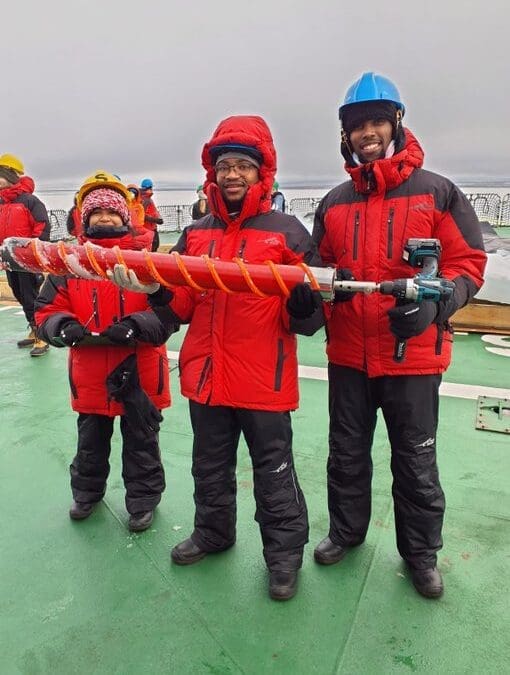

![]()

